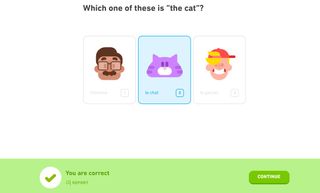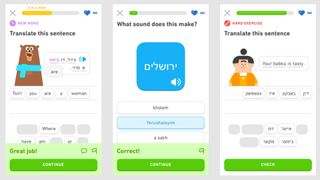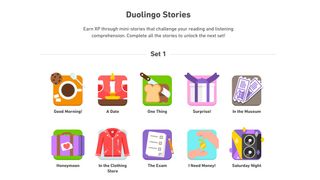Duolingo is one of the best-known online language-learning platforms. A free app, designed to rival the quality of paid-for language software, the platform has built a loyal following of users since its launch in 2012. Today, over 500 million learners have used Duolingo to learn close to 40 languages.
Duolingo acknowledges how expensive learning a new language can be, and also the opportunities it can offer. As a result, the platform pledges to offer a wide range of high-quality courses and keep its promise to remain a complimentary platform. Naturally, this is a big draw for users. The languages available range from more popular choices such as, French, Hindi, Japanese and Spanish to lesser-chosen options, including Navajo, Swahili, Thai and Yiddish.
The platform interface is both colorful and fun, making it is easy to navigate and enjoyable to explore. There are two levels of membership offered – the free plan and Duolingo Plus premium service – the latter of which is not crucial to the language-learning experience (more on that later).
We rate it highly; it comes second in our guides to the best learn Spanish online courses and the best learn French online apps and websites. What's more, we're confident that you'll enjoy it, too.
Duolingo review: Teaching methods
The Duolingo dashboard sets out a clear lesson structure in your chosen language, with a flow chart of topics to follow. Before you start, you will be asked how long you’d like to spend learning each day. From then, the platform will encourage you to maintain this goal by sending gentle reminder notifications via email or the app.
Beginners start with the basic topics, including greetings, introductions, and people. Those who know the basics can take a short quiz and skip to the next level. Each topic offers between two and six lessons, with each lesson building on the vocabulary from the one before. This compartmental-style method of learning is useful for cementing words and terms to memory through soft repetition and focus. It also allows the user to tackle one subject at a time, meaning you don’t feel too overwhelmed with information.

Lessons comprise of writing down spoken phrases, dragging and dropping words in both English and your chosen language and repeating audio clips out loud. The written element is particularly useful for learning spellings, while the audio clips are ideal for perfecting pronunciation and structuring sentences. There is also an audio-focused tab on the app, that trains the ear to listen to conversations and pick out key elements of the discussion, such as prices or places.
Each lesson feels in-depth and thorough without being intense or too repetitive – and every level comes with a little information box that can provide context to the topic before you start. Points are earned as you pass each lesson. The more you complete, the more points you earn, placing you onto the Duolingo leader board for that language on that day. This acts as an incentive to keep showing up for daily lessons, to maintain your performance ‘streak’.
At the end of each level, users are given a short quiz to ensure they have picked up the themes so far. If any lessons are unclear, you can go back and take them again – they only take a few minutes – which assists users to pass the level with confidence. The intermediate stages teach topics such as shopping, weather and health, alongside past and future tenses. Advanced topics address vocabulary in science and medicine and more complex grammar – including idioms and the pluperfect tense.
Duolingo review: How the mobile app works
The free mobile app follows the same navigation and lesson structure to the online platform. You can sign up using an email address, or Facebook or Google log ins and progress is updated on both the app and the website, so you will always return to the place you left off during your last session.

There are minimal differences between the app and website experience. However, one of the most distinctive is a selection of beginner-friendly audio clips and intermediate level podcasts trialed for Spanish and French learners. Each 20-minute audio can be played via the app (or downloaded, with Plus, to a podcast app such as Apple Podcasts) and features an English translator providing brief summaries of the clip. This function is superb for practicing oral skills.
The main functional difference is that when using the app, users are given five hearts to start off with – and in the same way lives are lost during a video game, one heart is lost each time you fail an exercise. When you run out of hearts, you can no longer take lessons until you refill your hearts again. This has to be done by playing around on the app and earning ‘gems’, which can be swapped for hearts, or by waiting for some time before trying again – it takes five hours to refill each heart. As such, it is advisable to work mostly on the website and save the mobile app for when on the move. However, if you are regularly out of data or Wi-fi range, you may want to consider subscribing to Duolingo Plus, to download lessons for offline use. Also, hearts are automatically refilled when using Plus.
Duolingo Spanish review: Price
Duolingo offers two plans: Duolingo Free and Duolingo Plus. The complimentary service is upheld thanks to advertising revenue and remains wide-ranging and comprehensive in content. The Plus option, which costs $12.99 per month or $79.99 annually (or $47.99 for six months upfront), offers a few simple extras to those who predominantly use the mobile app, but is by no means necessary to engage in the full language-learning course. The main benefit of Duolingo Plus is to download lessons directly within the mobile app to use offline. The Plus app experience is also ad-free.
The Plus option is roughly the same price as Rosetta Stone, but we'd argue that the latter platform offers a bit more punch for that price. If you are budgeting, then Duolingo is the best free option currently available; platforms like Busuu also offer free-tier memberships, but you can only learn one language at a time.
Duolingo review: Additional features
The menu navigation contains a user forum, allowing students to ask questions, assist each other and discuss their leaning experience. There is also an events board sharing details of paid-for tutorials and seminars that users are invited to join. The ‘Words’ tab sets out the vocabulary you have learnt throughout the course and indicates whether you need more practice – while the Shop allows you to ‘buy’ yourself time for inactivity.

The Stories feature contains effective oral practice and is currently available to those learning Spanish, French, German and Portuguese. Here, a native speaker reads out a short story before users are encouraged to re-read the transcript into the microphone to practice pronunciation, while also answering some written questions to assess understanding. Stories become harder as you progress.
Duolingo review: Is it worth it?
Duolingo’s language options and course structure could certainly rival those offered on paid-for platforms. The fact that courses are free, and available in both website and app forms, makes this a highly accessible, easy-to-use and inclusive learning platform. As shown with the Stories and Podcast features, some of the language courses are stronger in content than others. This is worth bearing in mind if you wish to learn one of the lesser-picked languages. Nevertheless, all courses provide solid learning material for beginners, intermediate learners and advanced students.


